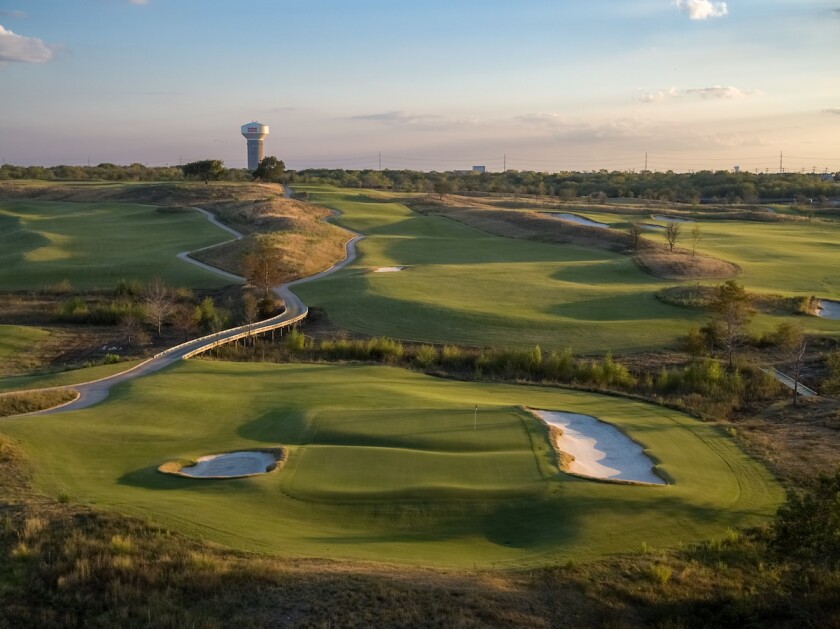It’s hard to imagine a more robust recovery for any business, let alone the golf industry, than what’s happening now with new course construction and major renovations throughout the United States.
Most of the sport’s top architects are booked through 2026 — and with no end in sight.
"It’s an environment that we could have never imagined," says longtime golf course architect Bill Coore of famed architectural firm Coore & Crenshaw. "Even in the late 1980s and '90s when many golf courses were being built we could never have envisioned that people would be calling and asking us to design courses for them and scheduling them two, three and four years in advance. That’s just unheard of."

Golf course architecture following the housing crisis of 2008-09 was at a virtual standstill, with some in the industry heading to the Pacific Rim area of the world to keep their businesses afloat. Others battled for the few crumbs that were available at home — and hoped for the best.
"Yeah, there have been a lot of ups-and-downs over the years, but there has never been anything like the number of inquiries we've had the last two years," says Scotty Sayers, who has been Coore & Crenshaw’s business manager for four decades. "When the country got locked down in March 2020 we thought that might be a time when some of our jobs got canceled. But instead, all of a sudden six months later the phone was ringing like crazy and it there was a lot of the work for architects. Many clubs realized that they've got some age on them and needed modernizing a little bit."
There are many factors involved as to why golf course architecture is booming in 2023. The popularity of the sport during the COVID-19 lockdowns played a major role, and helped trigger additional dynamics that have led to the unprecedented construction surge.
"We’ve all seen that data, and the translation in our business is that about 50 percent of private clubs in America are now full and have waiting lists," says Tom Marzolf, longtime senior design associate for Fazio Golf Course Designers. "That’s new to the industry. So with clubs being so healthy and clubs operating at full budgets there's money left over now to look at deferred maintenance and deferred projects, and that has led to renovation work within the whole industry.
“And that’s going to continue because when a person joins a club and writes a check to join and pays an initiation fee they're not going to walk on that initiation fee. So this surge should last a few years and we’re seeing that even in a recession the last few years. That’s a positive for the game."
The recent population migration to certain states, for example Florida, has also produced an urgent need for more golf holes. And with more than 40 golf layouts designs over the years in the Sunshine State maybe no other firm is in a better position to speak on demand there than the Fazio team.
“There’s a lack of inventory for golf lots or golf homesites, not just in Florida, but up-and-down the East Coast because residential golf has not been built since the crash of 2009,” Marzolf says. "In Florida, you can't join a club unless you're going on a waiting list. And there isn't a place for you to buy a home or build a home, so if you're residential developer golf is wide open right now for someone to say, ‘OK, let's put in some residential golf with 350 homes.’ That's new, and that's going on right now. Developers are seeing that opportunity to build some inventory because there isn’t any. It’s simple supply and demand for real estate golf.”
During the golf real estate boom on the 1980s and ‘90s, Coore notes that developers wanted more immediate construction results, and would likely not schedule ground breaking two or three years down the road like some are doing now just to get on the books.
"The developers were not that understanding; they had timelines, they had budgets to meet, they had schedules and all sort of major development plans, and the golf course was more of less secondary at times,” Coore says. “Times have changed. Now it seems to be that golf courses are perceived to be valuable entities in and of themselves. We could just never have imagined it in those terms."
Prior to 2006, there was a 20-year expansion cycle where U.S. golf course supply grew by 44 percent, according to the National Golf Foundation. Since 2006, there has been a cumulative contraction of approximately 12 percent.
Expect that last figure to change dramatically in a positive direction in the next few years, according to golf architect project spreadsheets.
“This is a time in the business when it's fun because you can be creative and pick some good jobs,” Sayers says. “The hard thing I have to do is say ‘no’ to people when they call, that we’re booked and we can’t take on their project because it's their dream to build a golf course.”
It has been a decade since Coore & Crenshaw opened the award-winning Streamsong Resort Red Course in Florida. Sayers and others are once again seeing a trend toward more "getaway" locations that accentuate a golf experience.

In the first few months of 2023, Tom Doak is hard at work on the new Pinehurst No. 10, Fazio just announced a project in Georgia at Reynolds Lake Oconee, the Omni PGA Frisco (Texas) Resort opened with Beau Welling- and Gil Hanse-designed courses in early May, and the Keiser brothers, Michael and Chris, have started developing Colorado's Rodeo Dunes, the latest Dream Golf destination that also features Bandon Dunes, Sand Valley and
Cabot Cape Breton in its portfolio.
“People are coming back to golf, and also staying in golf, which has created a bigger interest where a lot of cities and a lot of places are under golfed when it comes to the golf course inventory,” Sayers says. “Municipal courses are full all the time; daily fee courses are full and country clubs have waiting lists. I think that holds true in most parts of the country.”
The average golf member in America lives within seven miles of a course, so the key is striking a balance between securing land for new golf projects that makes monetary sense moving forward, Marzolf says.
“It’s real tough in certain places, but on the flip side get up in a plane, fly around and see how much raw land is sitting everywhere,” he says. “There’s land everywhere. I've heard this said all my life: “How could there be more golf courses? There's no land.’ Well let's go to Montana and I’ll show you some land.”
“It’s certainly not only us, it’s all of our associates and our friends in the business that we talk to who are also so very busy,” Crenshaw says. “It seems like people want to build courses and they have a dream of these different places. I suppose that these remote, destination places are becoming fairly popular. You know, one or two groups can go to these places and play a few days and then go back out again.
And there are more to come.
“Yes, Scotty has had a few calls to deal with,” added a chuckling Crenshaw. "It has been unbelievable; just amazing times."











